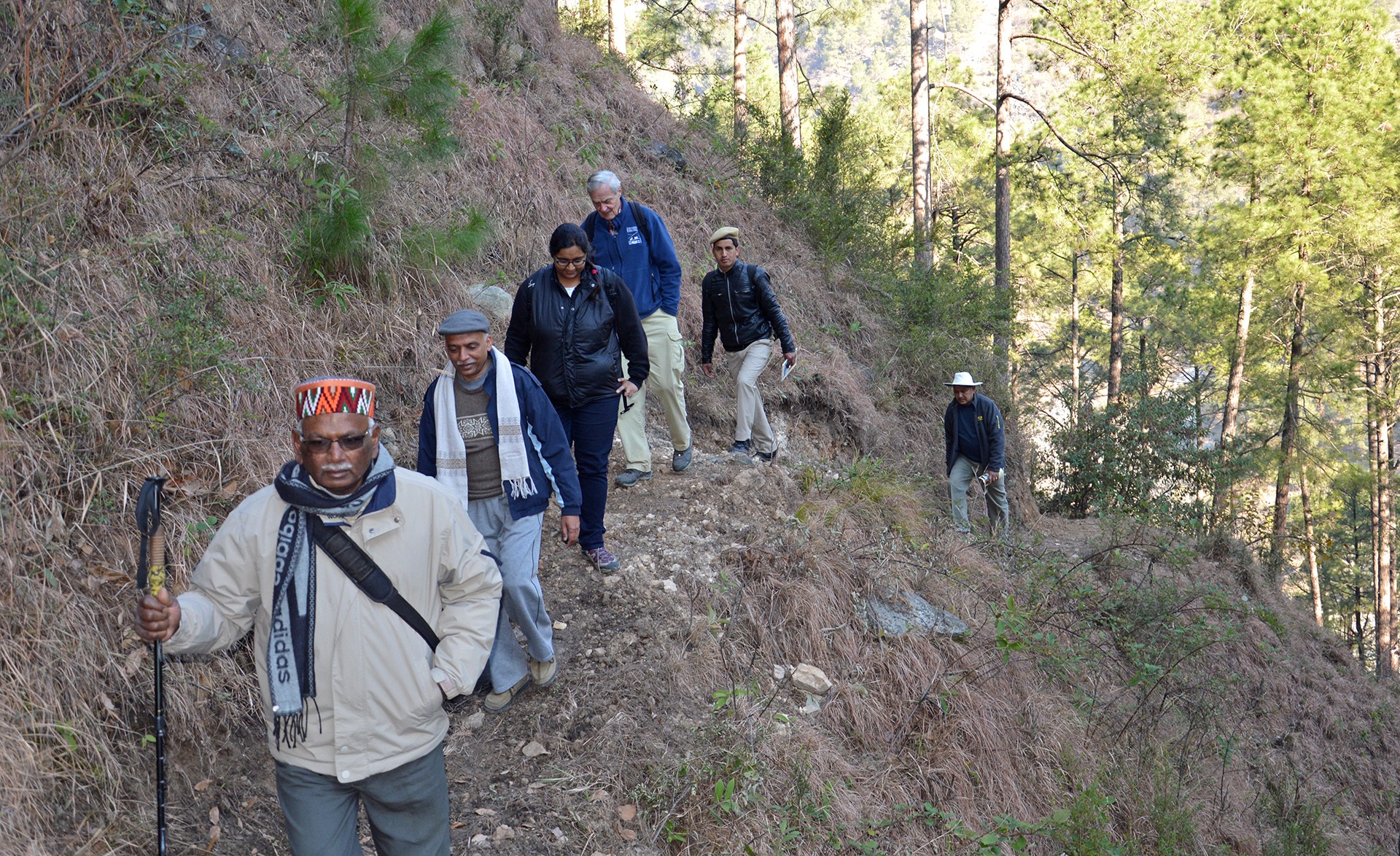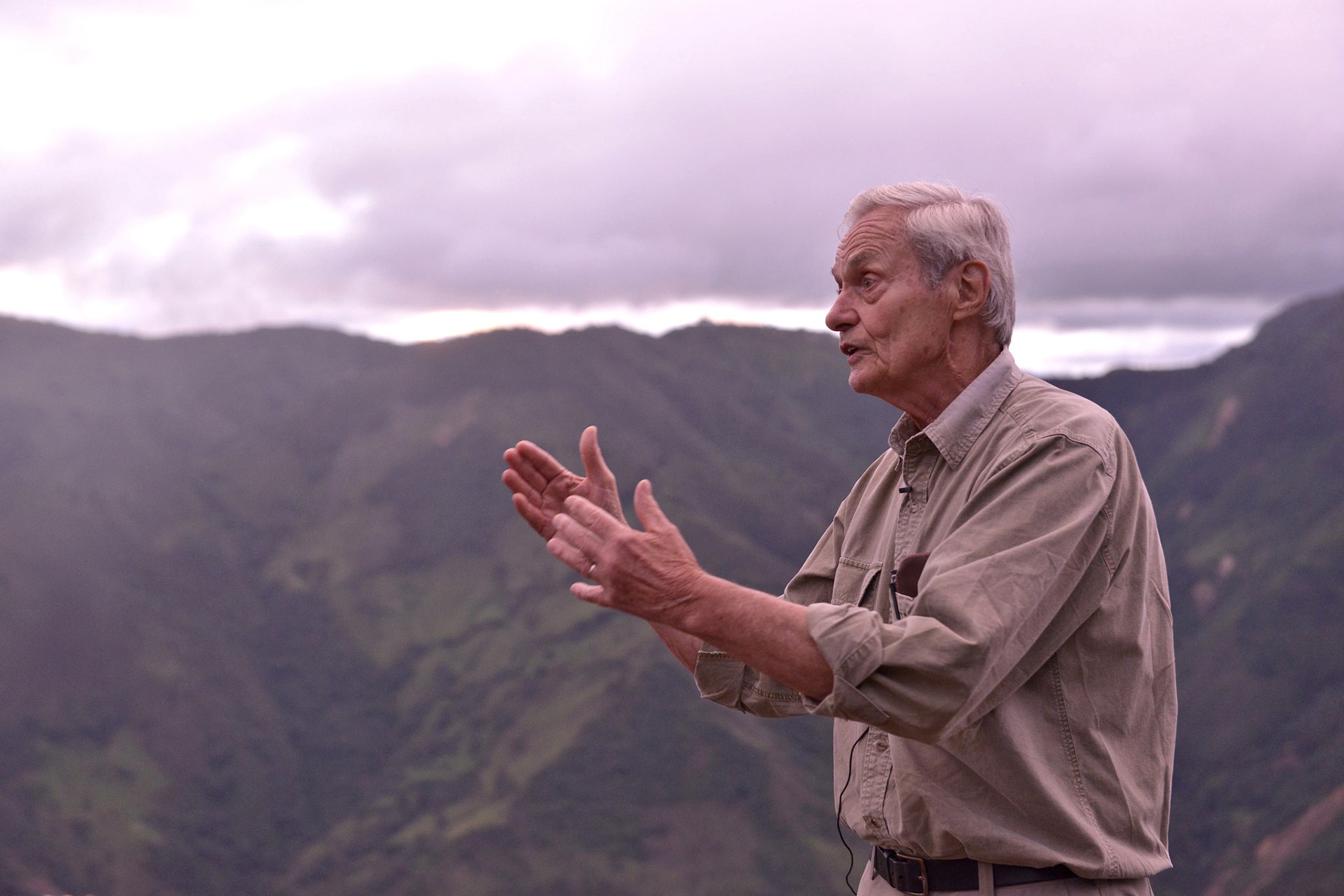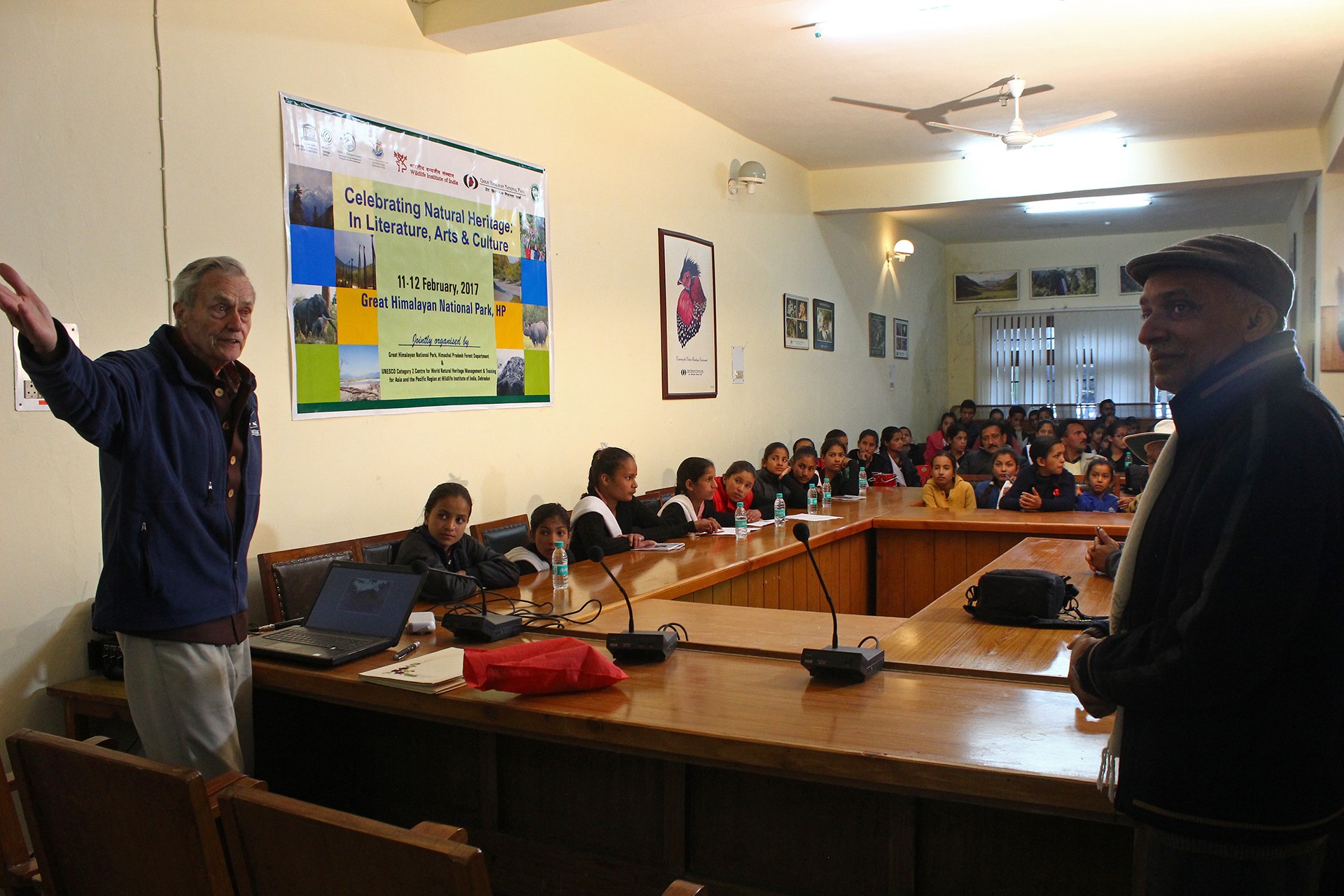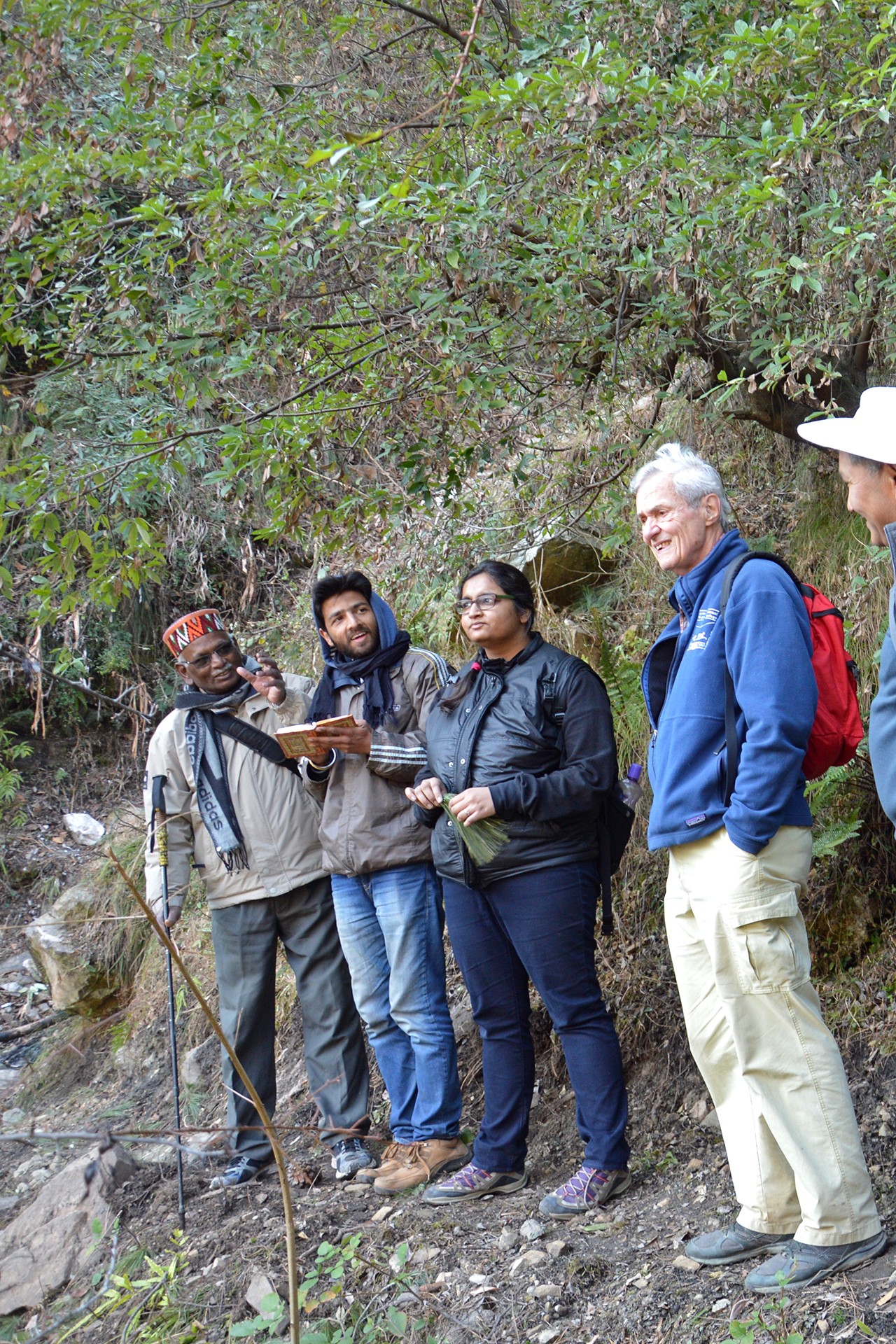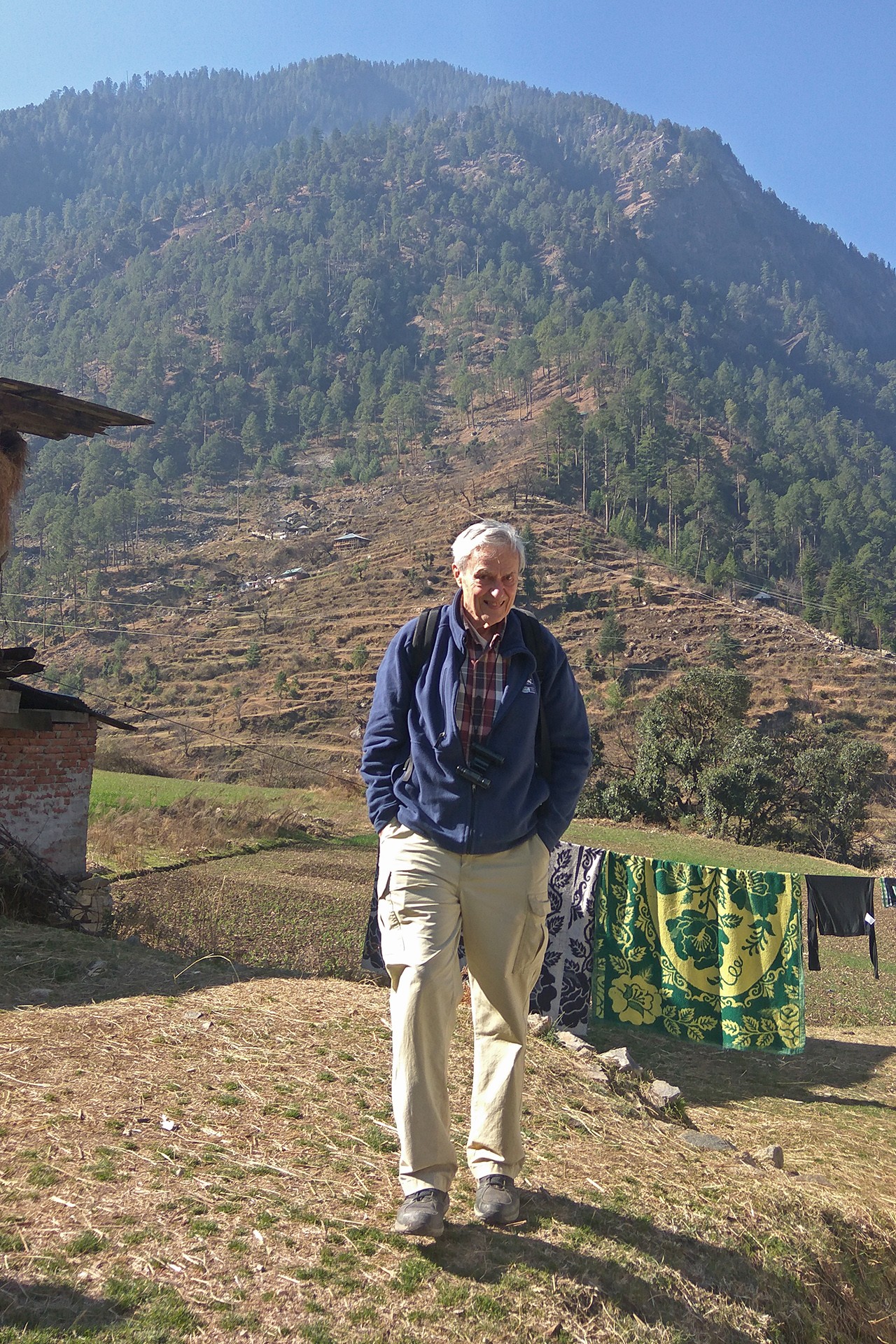In February this year, I trekked up the mountainous trails of Tirthan Valley, slowly making my way through the lush coniferous expanses bordering the Great Himalayan National Park (GHNP), in Himachal Pradesh. My destination was the Chhoie Jharna, a humble waterfall that pierces the rocky valley, located a pleasant hour’s climb away from our Forest Rest House at Sai Ropa.
Scrambling together to spend a few morning hours walking through the mountains, our group of about a dozen made its way uphill, enveloped in the dense silence of the hills.
Over the years, I have often found myself escaping to remote hilly paths for the nostalgic peace of the mountains, but at this moment, I was far from calm on the inside. Pacing alongside me was Dr George Schaller, and I couldn’t quite process the fact that I was meandering through these mystical Himalayan trails alongside him.
George Schaller is a pioneer in the field of wildlife biology and conservation. I first heard of him when I began working with my mentor, a prominent conservation journalist. You can’t work for conservation and not have read Schaller, she stated. I remember poring through her copy of A Naturalist and Other Beasts, being struck by his intimate accounts of observing gorillas and Snow Leopards, and surprised that so few knew of him.
Sir David Attenborough once said of him: “He is far more interested in getting the facts out than making a name for himself.” He’s not wrong, for despite his ground-breaking research, Schaller isn’t a household name, even within the conservation community.
He has spent nearly six decades traversing, studying and striving to protect the world’s forests and natural landscapes, creating a legacy that spans continents and generations. Through his efforts, thousands of acres have been designated as protected wildlife refuges across the planet.
Since the 1950s, Schaller has been involved in scientific studies and conservation efforts for some of the planet’s most charismatic wild animals – the Mountain Gorillas of the African Virungas; the Snow Leopards of Nepal’s Dolpo and Pakistan’s Hindu Kush mountains, the Bengal Tigers of Central India’s forests, the Giant Pandas of China, the ungulates of the Himalayas, including Tibetan Antelopes and the Marco Polo Sheep, the Jaguars of South America, the Asiatic Cheetahs of Iran – and that’s just to name a few. He’s the recipient of a National Geographic Lifetime Achievement Award and the Tyler Prize for Environmental Achievement. Today, at the age of 84, he continues to travel to these landscapes where he pioneered ground-breaking research, and check in on the work that scientists and conservationists carry forward today.
Schaller was only 26 when he moved to Africa to study Mountain Gorillas. This was during a time when the general perception was only that gorillas were large, scary beasts. Schaller’s study (the theme of his book The Year of the Gorilla, published in 1964) was arguably the first in-depth scientific account of this species’ behaviour. In the book, he wrote: “No one who looks into a gorilla's eyes – intelligent, gentle, vulnerable – can remain unchanged, for the gap between ape and human vanishes; we know that the gorilla still lives within us.” Thanks to Schaller, we learned that gorillas are gentle giants with complex social structures very similar to human families. His work was later built upon by legendary conservationists Jane Goodall and Diane Fossey. Fast forward to half a century later.
Today, too, the world’s foremost wildlife scientist refuses to reduce animals solely to data and statistics; it’s clear he has a deep emotional connection to the animals he has studied. Speaking on conservation, he has often said that the best science in the world is not relevant if emotion isn’t involved.
Most of us who work in conservation know this emotional, evocative joy of being in the wild, and feel a need to protect these spaces. Yet, victories are rare, the odds are very rarely in our favour, and cynicism comes too easy when we see the wilderness we so love constantly eroded and devastated. Writer and environmentalist George Monbiot argues that environmentalism is also afflicted by a deeper failure: arising possibly from embarrassment or fear, a failure of emotional honesty. So, it is often the case that scientists privilege data and statistics when making the case for conservation, and brush away any talk about recognising a deeper, spiritual connection to nature. This is something I often find myself struggling with, and to hear an authority like Schaller unwaveringly support the importance of being honest about our work in this way was heartening.
Dr Schaller (“the name is George”, he would say to anyone who called him Dr Schaller) would pace ahead with his hands loosely resting in his pockets: treading uphill, skipping over river beds and making his way over fallen logs. I noticed his stride hasn’t aged a day. “I love to walk!” he mused, when a much younger researcher from our group quipped that he was strides ahead of the younger lot.
In the week that I spent in his company, I came to realise that his energetic, open demeanour is typical Schaller. He introduced himself to an audience of 12-year-olds at the Sai Ropa Forest Rest House of GHNP, with a simple truth: “I like observing animals and writing their biographies. When I went to study gorillas, everyone said they were dangerous. But if you’re nice to animals, you can get used to each other and be friends.”
His wife, Kay, and their two sons accompanied him on various projects, and as the intrigued audience marvelled at photos of a family of Mountain Gorillas, a photograph of Kay nestled in the wilderness of the Virungas came up on screen. “This is not a gorilla,” he remarked, straight-faced, “This is my wife.” How surreal it was to meet the man himself and hear him casually recount his legendary conservation work with such wit and humour!
Schaller was on a trip to India from his home in Connecticut, USA. He was our guest for a natural heritage festival hosted by the UNESCO Centre at the Wildlife Institute of India, Dehradun (where I was working). After a week with us, his travels continued to the Garo hills of Meghalaya, and then to Pakke Tiger Reserve in Arunachal Pradesh. After a brief visit home to the USA, he travelled to Brazil to revisit Jaguar habitat as part of another conservation project. And just last month, he was back in India, this time for a trip to Ladakh, checking in on Blue Sheep and Snow Leopards in their mountainous habitat. (Did I mention that there isn’t much about him that gives away his years?)
Currently, Schaller is the Vice President Emeritus for the wild cat conservation organisation Panthera and a senior conservationist with the research organisation Wildlife Conservation Society. In fact, his association with big cats dates back several decades. In the 1970s, Schaller became the first Westerner to have ever photographed and studied the Himalayan mountain ghost, the Snow Leopard. That same decade, he wrote Stones of Silence, an account of his journey tracking the Snow Leopard, ungulates and other lesser-known wildlife in the Himalayas. He has since trekked through Snow Leopard habitat in Afghanistan, China, Tajikistan, Mongolia, Pakistan and India, pioneering research on the elusive predator – mostly, focusing on assessing its presence and behaviour as well as its interaction with humans. His work was key in pushing the establishment of several protected areas for Snow Leopards, most notably the Chang Tang Nature Reserve in Tibet – the second largest nature reserve in the world, and the Shey-Phoksumdo National Park, Nepal.
His work has long been an inspiration for many a young conservationist (myself included), and I was in awe, and somewhat stumped to be on a trek with him; literally following his footsteps up the hilly Himalayan trails.
We paced through the verdant valleys of Tirthan, but my mind fixated on memories from when I first walked through Central India’s vibrant Sal forests. It was December 2015 – I was a field volunteer with a team studying the tigers of Kanha-Pench, and didn’t know then, that one day, I would be trekking uphill with the first person to ever study tigers in India in the very forests I was walking. Dr Schaller’s pioneering study of the Indian tiger in Kanha in the 1960s (the focus of his book The Deer and the Tiger) has inspired generations of conservationists to build on his work and fight for wildlife and conservation – like legendary wildlife scientist Dr Ullas Karanth, to name just one. So, I decided to ask him for possibly the oldest first-person account I could get: how radically different were people’s perceptions of the tiger back in the 60s, when killing tigers was something to be celebrated? “All anyone ever wanted to do was shoot one!” he exclaimed.
It wasn’t a time of regulated and restricted ‘National Parks’, guarded forest rest houses, or fixed fences. There was no Wildlife Protection Act, nor Tiger Reserves. Did he worry about his young sons, with tigers frequenting the forest that was their backyard? “The boys were great in the field and the tiger is a gentleman, but the land nearby was rife with tiger signs. We drew a line in front of our home that they weren’t allowed to cross,” he recalled, smiling.
I had to inquire some more. Has Kanha changed dramatically since then? Yes. He spoke to me of vultures and diclofenac. “They were abundant, perched on virtually every tree back then. I barely spotted a handful during my last visit a few years back.” It’s true: IUCN has reported that the Indian vulture population has declined by more than 97 percent in just over a decade. They are listed as Critically Endangered.
There were so many questions I wanted to ask him, but I ended up picking one that many a conservationist must have asked him before: After all these years, is he still hopeful? “Hope is not my work. It’s action,” he responded.
But I have read his interviews and devoured his books; I know this answer. There is no end goal, no victories in conservation, he has said; only battles.
And so, I chose a more personal question. One that I was aching to ask, one that most of us who love and study the natural world continue to struggle with. How does he deal with the disillusionment of it all?
The official indifference, the large-scale vandalism of the earth’s natural systems, the carelessness of governments in safeguarding a country's natural treasures: how does he, having spent decades at the forefront of these battles, deal with it all?
His answer was simple. “You pick a conservation project where you know you can make a difference, and you keep working at it.”
Now, at 84, he continues to travel the world fighting for conservation, making every effort to ensure that a little more of our planet is protected for generations to come.
After over six decades of working for the conservation of nature and wildlife, he persists.
And so must we.
